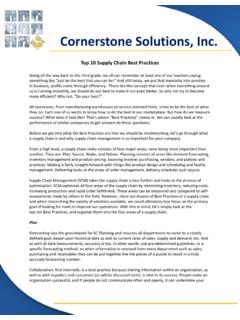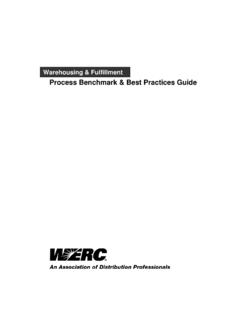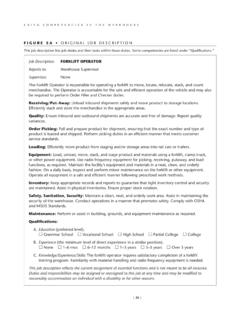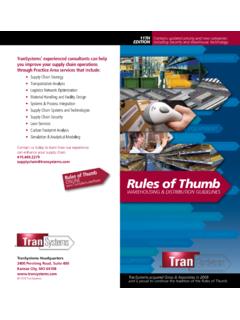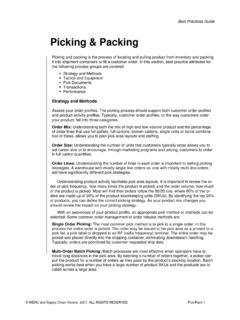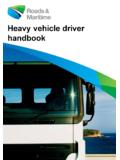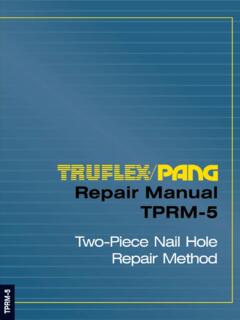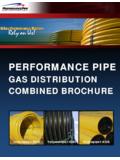Transcription of Forklift Safety: Reducing the Risk - WERC Warehouse
1 Forklift safety Reducing THE RISK2ND EDITIONFEBRUARY 2006 CONTENTSI ntroduction.. stability: the facts.. instability: the risks .. and stopping distances.. on and off: The safe way.. and load handling.. your Forklift .. safety tips for Forklift operators.. your workplace.. management planning.. 1410. Pedestrians and forklifts don t mix.. 1611. Reducing risk.. 1712. Policies and procedures.. 18 WorkSafe Victoria is a division of the Victorian WorkCover information presented in this guide is intended for general use only. It should not be viewed as a definitive guide to the law and should be read in conjunction with theOccupational Health and safety Act 2004. Whilst every effort has been made to ensure the accuracy and completeness of this guide, the advice contained herein may not apply in every circumstance. Accordingly, the Victorian WorkCover Authority cannot be held responsible, and extends no warranties as to: the suitability of the information for any particular purpose; and actions taken by third parties as a result of information contained in this information contained in this publication is protected by copyright.
2 The Victorian WorkCover Authority hereby grants a non-exclusive licence to the recipient of this publication on the condition that it is not disseminated for profit. The Victorian WorkCover Authority encourages the free transfer, copying and printing of the information in this publication if such activities support the purposes and intent for which the publication was VICTORIA/ Forklift safety Reducing THE RISK1A medium sized Forklift weighs about the same as youraverage dump truck and can cause just as much damageand would place tight controls on a heavy vehicle such as adump truck travelling around your workplace, and the samemust be done for a and managers must be aware of how a Forklift is operated, and the serious impact incorrect safetyprocedures can have on lives, families and Victoria has a zero tolerance approach to theunsafe use of forklifts one of the most dangerous pieces of equipment found at Victorian found to be using forklifts in an unsafe mannercan expect WorkSafe to act swiftly and enforce compliancewith workplace health and safety .
3 Injuries and workplace losses attributed to forklifts : In the period from January 1985 to January 2006, 56 Forklift -related fatalitieshave been reported to WorkSafe Victoria. 30 of these involved pedestrians; 16 were hit by loads and 14 struck by a Forklift . Ten of the other deaths were Forklift operators who either jumped or fell from a Forklift in a tipover and were then crushed between the Forklift and the ground. Tipovers (forward or lateral overturning) are the second highest cause of Forklift -related deaths. forklifts tip over too often and cause too many workplace incidents are warehouses and factories, shipping yards and freight terminals across Victoriaforklifts are used to lift, stack and transfer be effective, a Forklift must be manoeuvrable. To achieve manoeuvrability, forklifts are designed to be compact, making them less stable than other vehicles and mobile deaths and injuries continue to occur in Victorian workplaces.
4 By now it should be clear, forklifts and pedestrians do not work environments, effective employee training, well maintained machinery,systematic traffic management and effective supervision all play an important rolein Reducing the risks posed by forklifts in the work methods are unsafe or workplaces inflict demanding schedules onforklift operators, incidents those employed as supervisors/managers at workplaces where forklifts areused must know the impacts these heavy pieces of machinery can have on theiroperators and passing have a range of limitations, from maximum load weight to speed. Thesefactors affect the operator and the Forklift itself, employers should ensure theworkplace conditions suit the Forklift and the tasks it guidance material has been developed to extend the current state ofknowledge on Forklift safety in general, and on Forklift stability in VICTORIA/ Forklift safety Reducing THE RISK1 Forklift STABILITY: THE FACTSWORKSAFE VICTORIA/ Forklift safety Reducing THE RISK3 Driving with raised forks, cornering too fast, striking low doors or beams, drivingacross inclines and uneven ground are the main causes of forklifts with another vehicle, braking too quickly and towing disabled forkliftshave also caused overturns and tip over too often.
5 Changes to workplace practices and people s behaviourin and around forklifts need to be made. Make changes INSTABILITY: THE RISKS56 REPORTED FATALITIES INVOLVING Forklift TRUCKS 01 JAN 1985 TO 30 JAN 2006 Fell from Forklift , forkarms or load (8) Operator crushed by unexpected movement of Forklift (7) Operator overcome by exhaust fumes (1) Pedestrian crushed by falling loads (16)Operator crushed by Forklift in tipover/rollover (10)Pedestrian crushed by manoeuvring Forklift (7) Pedestrian struck by travelling Forklift (7) 4 WORKSAFE VICTORIA/ Forklift safety Reducing THE RISKFORKLIFT INSTABILITY: THE RISKSPUT SIMPLY, forklifts OVERTURN AS A RESULT OF: Travelling with forks raised and no load. Turning sharply. Travelling across an incline or unevenground. Travelling with a raised load. Carrying a load forwards down a slope. Carrying an unevenly balanced load. Braking hard when AND TIPPINGO verturning poses the most danger to Forklift operators in the is a leading cause of deaths involving forklifts , accounting for one in six an operator jumps or is thrown from an overturning Forklift , more often than not they end up trapped under the overturned Forklift and a fatality major cause of forklifts tipping over is when the forks are elevated with no load.
6 This is made worse if the mast is tilted back. forklifts tipping overcontribute to a large proportion of Forklift funded research identified 10 key concerns in relation to Forklift stability:1. Most rollovers involve unladen forklifts , making the truck more unstable than a laden Forklift with the load being carried When operators apply the brakes on a laden Forklift they easily lose Even when stationary, forklifts have a small stability safety margin 30-50% at rated load with the load down and 15-20% with a fully elevated load andmast Manufacturers information does not always detail if the Forklift s workingcapacity has been restricted by stability tests relating to (lateral) overturning or(longitudinal) Manufacturers do not always include vital information, such as the Forklift scapacity at full forward tilt of the mast and at maximum load elevation, in theirsales Uneven flooring, particularly with a height difference in excess of 20mm acrossthe front wheels, can seriously impact on a Forklift s stability when carrying itsrated load at full When undertaking high lifts, particularly over four metres, dual wheel forkliftsshould always be When driving with a raised load or a raised empty load carriage, a Forklift maybecome dangerously Loads attached to a Forklift or suspended from a jib attachment are more likelyto result in a full forward tipover when forklifts can easily overturn if they make contact with overhead capacity, the maximum load supported by the lift, and vertical lift travelare the most important Forklift specifications to be considered in order toprevent Forklift instability INSTABILITY.
7 THE RISKSWORKSAFE VICTORIA/ Forklift safety Reducing THE RISK5 MANAGING THE risks , IF YOU ARE AN OPERATORW hile every step must be taken to minimise the chance of a Forklift incident, it is wise to be aware of what to do should you be involved in a Forklift is travelling around a corner or down a slope, when it acceleratesor brakes, forces are developed that can result in it rolling sideways, tippingforwards or a Forklift overturns, the safest place for the operator is in the cabin with aseatbelt on. Body restraints should be fitted and worn. The operator is advised tohold on, stay with the truck and lean in the opposite direction of the every time an operator jumps from their Forklift while it is overturning theyare killed. While seatbelts can be a nuisance, they can also be a life a reach truck or stand-up type Forklift with rear access, seatbelts should beworn if THE risks , IF YOU ARE AN EMPLOYERE mployers have a primary duty to provide a safe a safe work environment, training, well maintained machinery andeffective traffic management plans all play an important part in Reducing the risksposed by forklifts in the employees, including managers and supervisors, have a duty to ensure theactions they take, or neglect to take, do not put themselves or others at it can be proven that an employer s negligence has contributed to a thirdparty s injury, such as a customer or delivery truck driver, the Victorian WorkCoverAuthority (VWA) can, and does, seek recovery of costs against the employer underthe Accident Compensation Act 1985.
8 These costs could potentially run to millionsof dollars and have a devastating effect on any THE risks , IF YOU ARE A MANUFACTURER OR A SUPPLIERT here is a recognised need for manufacturers and suppliers to provide moreinformation on a Forklift s capabilities and users are not aware of a truck s limitations. This can lead to a Forklift being used close to its limits of the design process, manufacturers can take steps to eliminate risks posed byforklifts in the workplace by introducing, and promoting, intelligent systems (SmartForklifts) such as: mechanisms that prevent forklifts from starting when the driver is notrestrained by a seatbelt or another device; limiting travel speeds to as low as 8km/h (9km/h for dual tyred forklifts ), except where manufacturers can provide stability figures to show would assist in Reducing the occurrence of side tipovers. (Uneven operatingsurfaces could require a lower speed limit); speed limiters to reduce the maximum speed of a Forklift depending on theload, the height of the load and turning radius; systems to monitor and limit the number of wheel rotations while the forks are elevated to prevent forklifts being driven with raised forks; and load weighing devices supplied as standard equipment on VICTORIA/ Forklift safety Reducing THE RISKFORKLIFT INSTABILITY: THE RISKSM anufacturers should also provide information on a Forklift s limitations on uneven surfaces and while stacking with off-centre loads at full height, especially on asurface with a 2% difference in gradient (20mm in 1 metre), can significantlyimpact on Forklift commissioning a new Forklift , adjustments can be made to mast liftcylinders to prevent overloading.
9 The maximum hydraulic pressure should be set at about 110% of the rated load at full height with the mast are often supplied with decals or numbers painted on the side that can be mistaken for the Forklift s operating capacity. These should be removed orreplaced with numbers that represent the correct capacity for should incorporate swivel seats where practicable on forklifts toease the back strains caused to operators while turning to look should provide information and recommendations on dynamiceffects on stability of different tyre , using and maintaining attachmentsWhen an attachment is fitted to a Forklift the dynamic and operating characteristicsmay change, making it necessary to de-rate the Forklift capacity and restrict someoperating such as side shift devices, jibs and extension forks must have ratedcapacities and information on the type of Forklift that is suitable for use inconnection with such revised capacity when an attachment is used is to be endorsed on the load CAN HELP MITIGATE THE EFFECTS OF Forklift INSTABILITY BY: Establishing appropriately sized pedestrian exclusion zones.
10 The speed travelled and type ofload carried will impact on the size of the exclusion zone. Design all new workplaces to ensure pedestrians and forklifts are completely separated. Ensuring seatbelts are fitted, correctly worn and by installing intelligent systems preventingforklifts being started unless a seatbelt is fastened. Purchasing forklifts with speed limiting devices. Removing incentives that may encourage Forklift operators to drive too quickly. Reduce the speed limit around the workplace. Using forklifts with a greater capacity for a given load. Using dual wheeled forklifts that provide an extra margin of safety in lateral stability whenlifting loads above metres. Require suppliers to provide detailed information on all stability limitations, capacities atdifferent lift height and lift positions and how the limiting capacity was obtained. Consider buying forklifts with a slightly higher capacity than actually needed at theworkplace.
